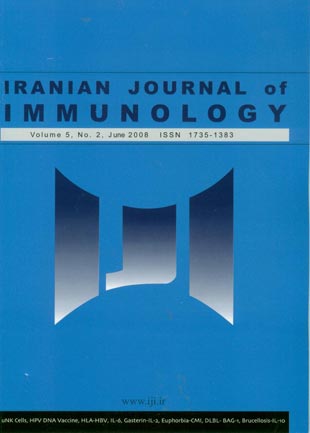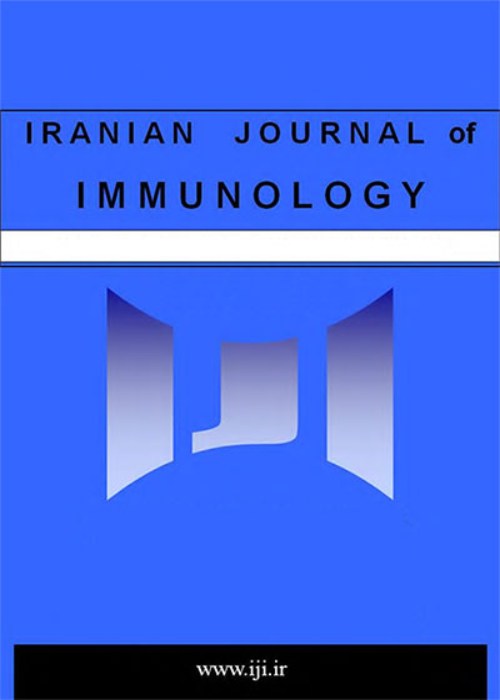فهرست مطالب

Iranian journal of immunology
Volume:5 Issue: 2, Spring 2008
- تاریخ انتشار: 1386/05/11
- تعداد عناوین: 8
-
-
Page 82BackgroundCervical cancer is the most prevalent tumor in developing countries and the second most frequent cancer among female population worldwide. Specific human papillomaviruses and, most notably, HPV types 16 and 18 are recognized as being causally associated with cervical carcinomas. The early HPV type 16 genes, E6 and E7, directly participate in the in vitro transformation of primary human keratinocytes and represent an excellent target for immune therapy of HPV related disease.ObjectiveThe aim of this study was the evaluation of the efficacy of a DNA vaccine containing human papillomaviruse type 16 E7 gene (Iranian isolate) in induction of CTL responses in an animal model.MethodsIn this study, the expression vector containing HPV type 16 E7 gene was constructed and chosen as a model antigen in the development of a therapeutic DNA vaccine in an animal model. CTL responses, cytokine assay, lymphocyte stimulation test, CD4 and CD8 staining and flowcytometry were done for evaluating of the immune responses.ResultsOur findings indicate that the target DNA vaccine can induce an E7-specific CTL response, which is important in the lysis of infected tumor cells, compared to negative control (p<0.005) after in vivo immunization in the mouse system.ConclusionThe developed vaccine may be promising as an anti-cancer vaccine.
-
Page 92BackgroundDifferent studies have demonstrated that a small proportion of healthy individuals receiving the hepatitis B (HB) vaccine do not produce protective levels of anti-HB antibody, a phenomenon which could be linked to certain human leukocyte antigen (HLA) class-II alleles or haplotypes.ObjectivesThe present study was undertaken to determine the frequency of HLA class-II alleles in Iranian healthy adult responders and non-responders to HB vaccine.MethodsTwelve non-responders (anti-HBs antibody<10 IU/L) and 46 responders (anti-HBs antibody>100 IU/L) were tissue typed for HLA class-II. HLA-DRB1, DQB1 and DQA1 alleles were determined using polymerase chain reaction based on sequence specific primers (PCR-SSP) technique. Accessibility to excess amount of genomic DNA was possible using Epstein-Barr virus (EBV)-transformed B-cells established from all vaccinees.ResultsOur results demonstrated increased frequencies of HLA- DRB1*07, DRB1*03, DRB1*04, DQB1*0201, DQA1*0201 alleles and HLA- DRB1*07/DQB1*0201/DQA1*0201 and DRB1*04/DQB1*0302/DQA1*03011 haplotypes in the non-responder group. Comparison between responders and non-responders revealed only a significant difference for DQB1*0201 allele (p<0.05).ConclusionThese findings confirm the association of certain HLA alleles and haplotypes with the lack of antibody response to HB vaccine in an Iranian population.
-
Page 124BackgroundApoptosis and cell cycle regulation play an important role in pathogenesis and tumor progression in patients with Diffuse Large B-Cell Lymphoma (DLBCL). Bcl-2 associated athanogene-1 (BAG-1) is an antiapoptotic protein as well as a regulator of cell growth. There is no conclusive evidence about BAG-1 protein expression in this disease.ObjectiveTo investigate the expression level of BAG-1 protein in DLBCL.MethodsThirty patients diagnosed from 1997-2004, as having DLBCL, were selected. Also 30 normal lymph nodes were included as normal counterparts in this study. BAG-1 expression was determined by immunohistochemical staining in both DLBCL and normal lymph node samples.ResultsOf the 30 DLBCLs examined, 100% were positive for nuclear and 83% were positive for cytoplasmic BAG-1 staining. Of the 30 normal lymph nodes investigated, 20% were positive for nuclear and 0% were positive for cytoplasmic BAG-1 staining. Nuclear staining in DLBCL samples was significantly higher than those of normal lymph nodes (100% versus 20%, p <0.001). Besides, cytoplasmic staining in DLBCL samples was significantly higher than those of normal lymph nodes (83% versus 0%, p <0.001). There was no association between BAG-1 staining and patients’ overall survival.ConclusionOur data indicated that BAG-1 protein was deregulated in this disease similar to some other malignancies such as breast and colon cancer. Overexpression of BAG-1 in DLBCL suggests that this protein probably plays an important role in the pathogenesis of DLBCL. Besides, higher nuclear BAG-1 staining might be correlated with poor prognosis.


